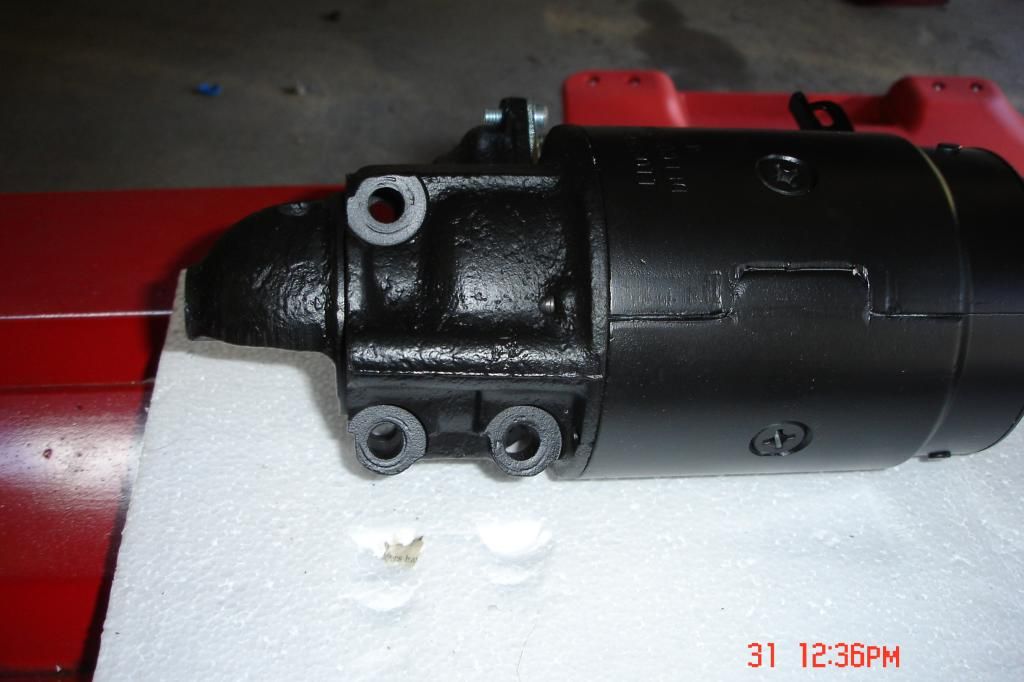It was worth the wait to get one of his starters. I noticed that the replacement starter only had 2 bolts of equal length. Johns starter has 3 holes and most of the vendors show 2 bolts of different length. Which one are correct. Thank YouRoger
John Pirkle Starter
Collapse
X
-
Re: John Pirkle Starter
Roger-----
You didn't mention what your application is. It matters.In Appreciation of John Hinckley- Top
-
Re: John Pirkle Starter
Roger-------
Attached is a photo of an NOS GM #1108338 starter. This one is dated January 13, 1970 (0 A 13). The 1108338 starter on my original owner 1969 which is dated August, 1969 is absolutely identical. Note that the starter nose has only TWO holes. I also have several NOS examples of starter noses GM #1965721, GM #1969309, and GM #1984098. The 1965721 is the starter nose which GM says was used for 1966-69 Corvette 14" flywheel applications. The 1969309 replaced the 1965721 in October, 1969. The 1969309 was discontinued in December, 1983 and replaced by the GM #1984098. The latter was discontinued without supercession in July, 1994. ALL of these starter noses have TWO mounting holes.
I don't know where these " THREE hole" starter noses fit in or what the part number was. However, the three part numbers for the noses I described above are the ONLY ones ever cataloged by GM for a Corvette 14" flywheel application. 14" flywheels were used for all 1966-74 big blocks except L-88/ZL-1 as well as all 1969-81 Corvette 350 cid applications except ZR-1. It may be that the "THREE hole" noses were some sort of alternate piece used and, thus, may be original in some cases. However, I firmly believe that the "TWO hole" nose was, by far, the most typical.
DSCN3032.jpgDSCN3035.jpgDSCN3036.jpgDSCN3034.jpgIn Appreciation of John Hinckley- Top
Comment
-
-
Re: John Pirkle Starter
JR-------
There were 3 tapped holes in the block but only two were used for any application. There had to be 3 holes because the mounting bolt patterns for the 3 starter noses differed. It was like this
12-3/4" flywheel applications: aluminum nose, "straight across" bolt pattern. One long bolt (4.65"), one short bolt (1.84").
All 14" flywheel/flexplate applications through 1969 and all manual trans applications 1970-81: cast iron nose; "diagonal" bolt pattern. Two intermediate length bolts (3.625").
All 14" flexplate applications 1970-82: aluminum nose, "diagonal" bolt pattern. Two long starter bolts (4.65")In Appreciation of John Hinckley- Top
Comment
-
Re: John Pirkle Starter
Good info Joe Thanks. It also looks like there might be a knurled part of the bolts, hard to see or are they smooth. I guess they need to be blackened.JR-------There were 3 tapped holes in the block but only two were used for any application. There had to be 3 holes because the mounting bolt patterns for the 3 starter noses differed. It was like this 12-3/4" flywheel applications: aluminum nose, "straight across" bolt pattern. One long bolt (4.65"), one short bolt (1.84").All 14" flywheel/flexplate applications through 1969 and all manual trans applications 1970-81: cast iron nose; "diagonal" bolt pattern. Two intermediate length bolts (3.625").All 14" flexplate applications 1970-82: aluminum nose, "diagonal" bolt pattern. Two long starter bolts (4.65")- Top
Comment
-
Re: John Pirkle Starter
Roger------
All of the starter bolts have knurled shanks and that's very important. Also, the unthreaded shank is longer than on a standard bolt of the same overall length. One should never use regular, standard bolts for the starter application.
All of the starter bolts I've seen are zinc plated. This includes the long, intermediate, and short lengths. There may have been some that were black phosphate, though.In Appreciation of John Hinckley- Top
Comment
-
Re: John Pirkle Starter
I like the phosphate look over the zinc but don't want to be wrong. Paragon and Zip have the bolts so I will order them.Roger------All of the starter bolts have knurled shanks and that's very important. Also, the unthreaded shank is longer than on a standard bolt of the same overall length. One should never use regular, standard bolts for the starter application.All of the starter bolts I've seen are zinc plated. This includes the long, intermediate, and short lengths. There may have been some that were black phosphate, though.- Top
Comment

Comment